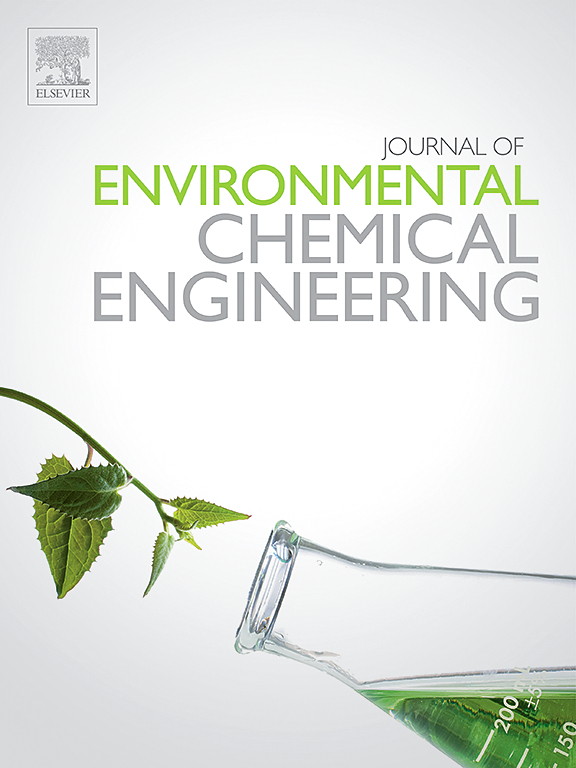Preparation of [C2mim][BF4]@ZIF-8/Pebax mixed matrix membranes for enhanced CO2/N2 separation performance
IF 7.4
2区 工程技术
Q1 ENGINEERING, CHEMICAL
引用次数: 0
Abstract
Mixed matrix membranes (MMMs) demonstrate promising separation capabilities for CO2 capture, representing a key area of current research interest. Nonetheless, the propensity for inorganic nanoparticles to cluster can degrade the CO2 separation efficiency. Addressing the challenge of nanomaterial aggregation within polymer matrices, this investigation employs a polyether-block-amide (Pebax), the ionic liquid (IL) 1-ethyl-3-methylimidazolium tetrafluoroborate ([C2mim][BF4]), and ZIF-8 to develop MMMs designed for CO2 separation. The preparation of the IL@ZIF-8 composite involved the wet impregnation method, while the IL@ZIF-8/Pebax MMMs were created through the solution casting approach. Analysis confirms the successful encapsulation of IL within the ZIF-8 nanocage structures, which can adjust the size of ZIF-8's pores. Concurrently, the IL@ZIF-8 composite material exhibits excellent dispersion within Pebax, which is conducive to exposing a greater number of active sites. Furthermore, the porous architecture of IL@ZIF-8 further facilitates gas adsorption and diffusion, leading to enhanced gas separation efficiency. As the IL@ZIF-8 loading hits 6 wt%, the MMM maximizes CO2 separation, offering a CO2 permeability of 169 Barrer and a CO2/N2 selectivity of 80, going beyond the 2008 Robeson upper bound and showcasing excellent gas separation functionality. This offers novel approaches for the development of more accurate and effective MMMs.
[C2mim][BF4]@ZIF-8/Pebax混合基质膜的制备及提高CO2/N2分离性能
混合基质膜(MMMs)在二氧化碳捕获方面表现出很好的分离能力,代表了当前研究兴趣的一个关键领域。然而,无机纳米颗粒的聚集倾向会降低CO2分离效率。为了解决纳米材料在聚合物基体中聚集的难题,本研究采用聚醚嵌段酰胺(Pebax)、离子液体(IL) 1-乙基-3-甲基咪唑四氟硼酸盐([C2mim][BF4])和ZIF-8来开发用于CO2分离的MMMs。IL@ZIF-8复合材料的制备采用湿浸渍法,而IL@ZIF-8/Pebax mm材料采用溶液铸造法制备。分析证实了IL在ZIF-8纳米笼结构内的成功包封,这可以调节ZIF-8孔隙的大小。同时,IL@ZIF-8复合材料在Pebax中表现出良好的分散性,有利于暴露更多的活性位点。此外,IL@ZIF-8的多孔结构进一步促进了气体的吸附和扩散,从而提高了气体分离效率。当IL@ZIF-8载荷达到6 wt%时,MMM最大限度地实现了CO2分离,CO2渗透率为169 Barrer, CO2/N2选择性为80,超过了2008年Robeson上限,展示了出色的气体分离功能。这为开发更准确、更有效的mm提供了新的方法。
本文章由计算机程序翻译,如有差异,请以英文原文为准。
求助全文
约1分钟内获得全文
求助全文
来源期刊

Journal of Environmental Chemical Engineering
Environmental Science-Pollution
CiteScore
11.40
自引率
6.50%
发文量
2017
审稿时长
27 days
期刊介绍:
The Journal of Environmental Chemical Engineering (JECE) serves as a platform for the dissemination of original and innovative research focusing on the advancement of environmentally-friendly, sustainable technologies. JECE emphasizes the transition towards a carbon-neutral circular economy and a self-sufficient bio-based economy. Topics covered include soil, water, wastewater, and air decontamination; pollution monitoring, prevention, and control; advanced analytics, sensors, impact and risk assessment methodologies in environmental chemical engineering; resource recovery (water, nutrients, materials, energy); industrial ecology; valorization of waste streams; waste management (including e-waste); climate-water-energy-food nexus; novel materials for environmental, chemical, and energy applications; sustainability and environmental safety; water digitalization, water data science, and machine learning; process integration and intensification; recent developments in green chemistry for synthesis, catalysis, and energy; and original research on contaminants of emerging concern, persistent chemicals, and priority substances, including microplastics, nanoplastics, nanomaterials, micropollutants, antimicrobial resistance genes, and emerging pathogens (viruses, bacteria, parasites) of environmental significance.
 求助内容:
求助内容: 应助结果提醒方式:
应助结果提醒方式:


